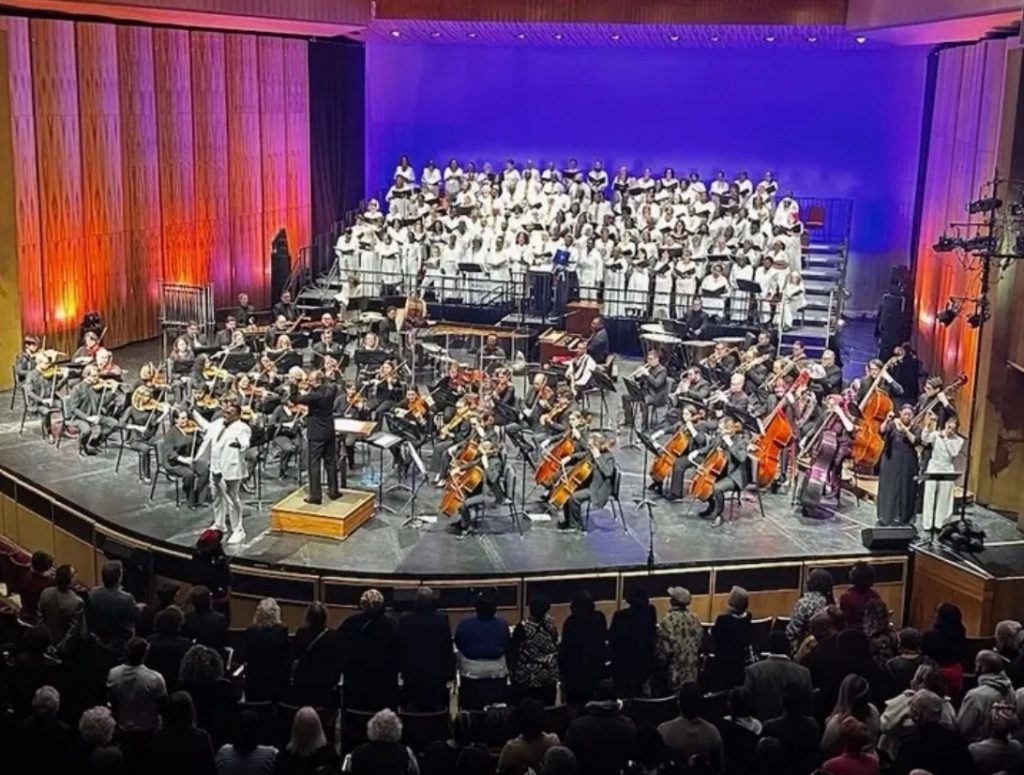by Kevin McLaughlin

ASO music director Christopher Wilkins was a genial host, downplaying his conducting role even while he did it skillfully. “The way to conduct these concerts is just to light the fuse,” he said. He spoke easily and warmly, an unabashed advocate of the program, eager to introduce the music and enjoy it along with the rest of us.
Jonathon Turner was the dynamic conductor of the choir, its members assembled from 56 church choirs from around the region. The rhythm section too, was outstanding — driven by Brandon R. Scarborough, piano, and force-of-nature Joseph Townsend at the Hammond organ. The temperature rose early, and never really came down.
The familiar Lift Every Voice — often called the Black national anthem — served as opener. The audience, still noisy and excited to see one another, rose to their feet and joined in, like a Sunday congregation.
Fellowship Medley followed — ASO violinist David Kempers arranged it, as he did many of the selections, to involve all forces present. Alto Liliani P. Williams rejoiced with the choir, and an exuberant trumpet (Jay Villella) and trombone (John Gruber) made for a nice instance of the orchestra getting swept up in the gospel singing.
Lutheran High School East students may have outshone even their elders after marching out to the apron to sing We Win and Somebody’s Knocking at Your Door. They lit up the place with their fine voices and synchronized gestures and gave plausibility to their designation as “GMS 2.0.”
This year’s classical programming came by way of Verdi’s Dies irae and the march movement from Tchaikovsky’s Sixth Symphony. But rather than create a sense of dialogue between classical and gospel, the works came off as intrusive.
The Dies irae (“Day of Wrath”) was mostly terrifying, as Verdi meant it to be. But it left the listener wanting, or maybe just perplexed, and the chorus seemed out of their comfort zone.
Possibly as justification, the Verdi was paired, attacca, with the spiritual My Lord What a Mornin’. It only seemed to make Verdi’s case worse. Both share a textual reference to the Judgment Day, but where the Requiem excerpt out of its larger context was just noisy, the spiritual, thanks to the divine voice of Brenda L. Justice, soared to empyreal heights.
An arrangement of the Psalm 34 text to an original tune by Pastor Jeffrey Dennis, Jennifer Jones, and Anthony Parker made an especially strong impression. Jones, now a recording artist, returned to GMS after ten years away to sing the solo part. The crowd’s enthusiasm was brought to new heights by the beauty of this music as they interrupted sporadically with bursts of applause.
The two Richard Smallwood compositions were especially well done. I Will Sing Praises saw Jennifer Jones assuming choral direction duties, and Jonathon Turner taking the podium to lead the orchestra. And Come Before His Presence was a Shirley Daley showpiece, impressing everyone with her Aretha Franklin-like virtuosity and a rapturous high note to end.
In a gracious gesture, Wilkins walked with microphone in hand around the stage to introduce every member of the rhythm section, before returning to the podium to conduct the final magisterial hymn, God Is My Everything.
A gospel version of Handel’s “Hallelujah Chorus” had to be repeated twice for encores, and even that didn’t staunch the applause.
Published on ClevelandClassical.com February 20, 2024.
Click here for a printable copy of this article
Return to the Front Page.



